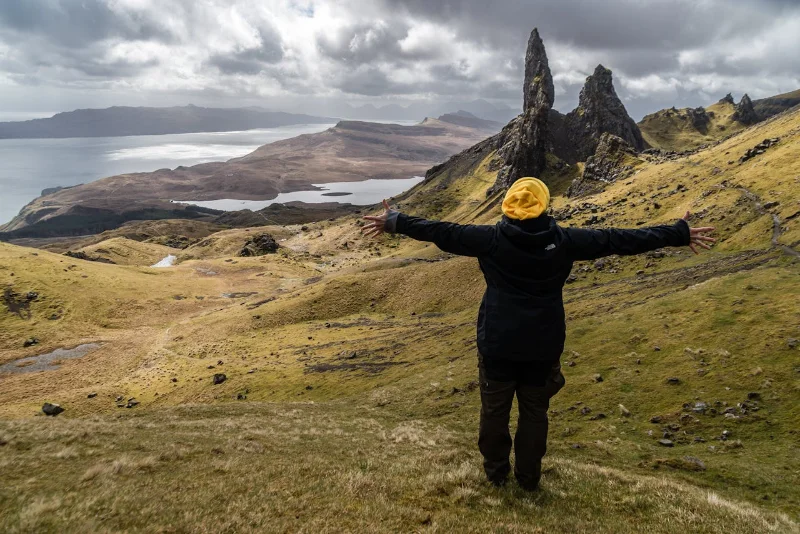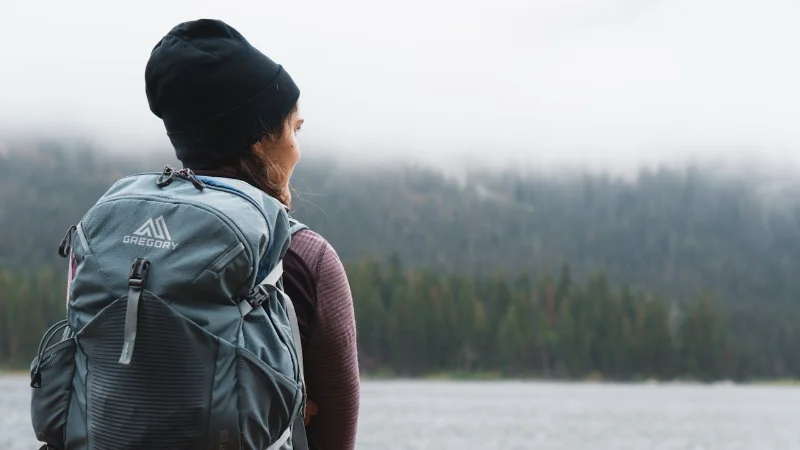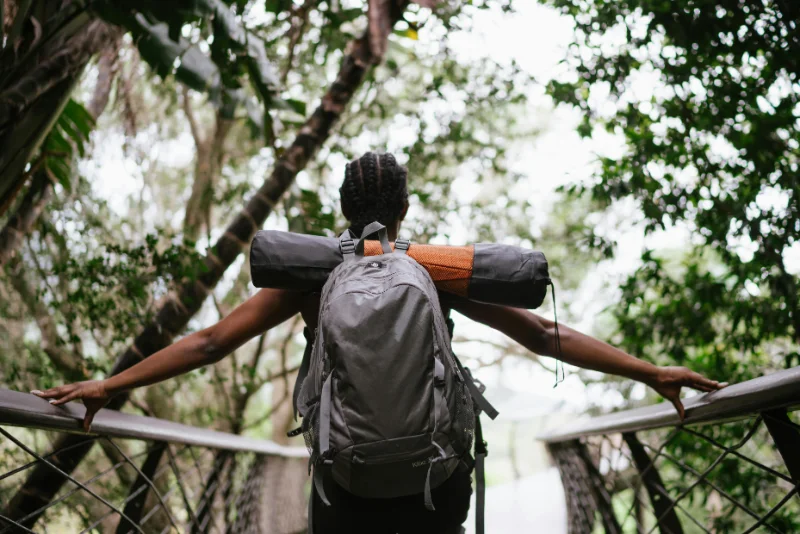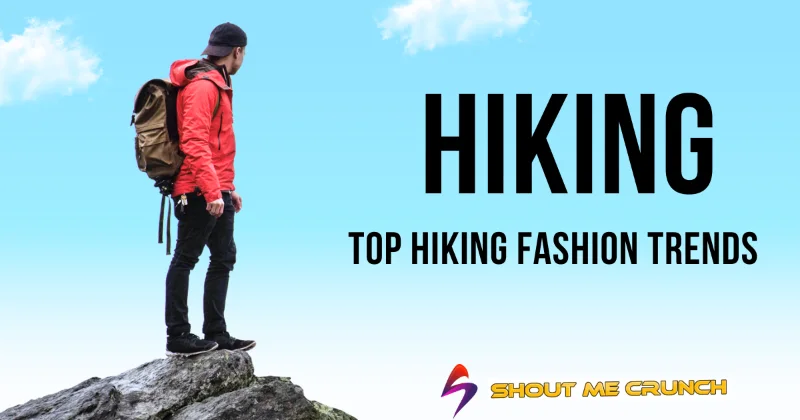Here’s a question we regularly ask ourselves when hiking: how do we dress? And obviously, we can’t escape it!
Should I take a third layer? Will my raincoat do the trick? Am I afraid of being cold or too hot? Will I still be too heavy? In short, here are some tips Anvisha gave and elements to consider, such as choosing your clothes carefully and being comfortable in your sneakers throughout the hike.
10 things to consider when dressing well for a hike
1- Seasonality
You can hike in all seasons, but it is important to bring appropriate clothing for each season. It may sound silly, but in winter, and this seems obvious, warm, waterproof, and breathable clothing is essential. In summer, light and breathable equipment is recommended.
Preparing for unpredictable weather changes is necessary regardless of the time of year. You must also protect yourself against the sun, wind, and rain and face bad weather.
Having a small waterproof jacket with you is always useful. If you are still deciding between a soft-shell jacket or a Gore-Tex-type jacket, we have written an article that could help you!
2- Temperatures felt
The temperatures experienced while hiking depend on many factors. They can vary considerably depending on altitude, weather, and season. Generally, temperatures when hiking in the mountains are cooler than along the coast or the plains.
In the clear, dry weather, temperatures rise to 25°C during the day and drop to 0°C at night. They can be lower and drop to -10 °C or lower in cloudy and humid weather. The temperatures felt differ from those displayed, and it is important to dress according to the temperature felt rather than that shown.
Conversely, we advise wearing a breathable material and a Freshwinner technical layer in summer for good sweat-wicking and quick drying.

3- The humidity level
The humidity level when hiking depends on the weather and the environment. In optimal conditions, an ideal humidity level for hiking is around 40-50%. Humidity levels can make the air warmer or colder, so it’s important to dress accordingly.
Use breathable and water-repellent fabrics which will protect you against rain and humidity.
4- UV penetration rate
We don’t always think about it, but the UV penetration rate in the mountains is generally higher than in coastal regions. The air is drier, and the sun is more direct. Weather forecasts usually indicate a higher UV index because of higher altitudes.
Mountains are, therefore, considered areas at risk of greater ultraviolet radiation. Protecting yourself against UV rays in the mountains or when the sky is grey is important! Long-sleeved clothes, pants, and sunscreen are your allies.
Lightweight polo shirts and t-shirts with a sun protection factor 40+ are also designed to wick away perspiration quickly.
5-Altitude
Altitude has a significant impact on the human body. As altitude increases, atmospheric pressure decreases, and oxygen available to the body also decreases.
This can lead to altitude symptoms, like headaches, fatigue, harder breathing, and sometimes mood changes. More serious symptoms can occur, but at higher altitudes, and involve respiratory failure, heart attacks, and neurological problems.
Altitude can make the air colder, so dress warmly to maintain your body temperature. Down jacket, fleece, and parka are welcome, but you should pay attention to the other layers of clothing!
A technical garment that fits the body as a first layer will be your first thermal insulator, allowing you to face the coldest weather.

6- The duration of the hike
It depends on your level, physical form, availability, and desires. If you’re a beginner, start with short, progressive hikes, increasing the duration and difficulty as you become more comfortable.
The duration of the hike must also be considered when dressing and equipment, providing a change of clothes if necessary, but above all, wearing effective clothing for the duration of the hike.
The breathable technology and the evacuation of sweat and odours allow the garment to be worn for several days without feeling discomfort while maintaining downy comfort on the skin.
7- The level of difficulty
The choice of a hiking route will also depend here on your level and objectives. You will have to consider your experience and physical condition, as well as the duration and difficulty of the course.
You can consult specialized sites for information on the different hiking routes. You can also ask for advice from professionals or friends who have already gone hiking. Anticipating remains the keyword.
During your hike, you will face different terrains depending on the chosen route:
- Flat terrain: flat and smooth terrain without obstacles.
- Hilly terrain: terrain with hills and valleys.
- Rough terrain: terrain with obstacles such as rocks, ravines, rivers, etc.
- Mountainous terrain: terrain with high reliefs
These are the elements that must be taken into account when dressing. The shoes must be adapted to the terrain, and your clothing must allow you freedom of movement to fully enjoy the experience.
8- Your fitness level
It’s certainly a truism, but being fit to go hiking is important. When you roam, you walk and may carry heavy objects. Additionally, the altitude and terrain can be difficult to traverse, so good physical condition is recommended to ensure a positive and safe experience.
Work out before you go; it will be even more enjoyable, and make sure you are healthy and fit. Depending on your training level, keep your bag manageable so that it does not slow you down in your activity. We often need more equipment.
9- The natural environment
The natural environment must also be considered to avoid accidents linked to plants, animals, and climatic conditions. Wearing a long-sleeved t-shirt or technical tights will protect you from insect bites or direct contact with plants on your skin. The hike will be more pleasant without bites, burns, scratches, and itching!

10- Equipment
As an example, here is a “to-do list” of basic items to take with you for a walking excursion or hiking excursion:
- Clothing in several layers, adapted according to the weather.
- Comfortable, sturdy, and water-resistant hiking shoes.
- A backpack adapted to your hike and your body type.
- A compass and a topographical map to orient yourself.
- A water bottle is an important and non-perishable food.
- A flashlight with working batteries.
- A lighter or fire starter and matches.
- A survival blanket (light, compact).
- A first aid kit with a basic pharmacy.
- A cell phone and an emergency signal.
- Gloves or undergloves, neck warmer, hat, and warm socks in winter.
- Hat, sunglasses, and sunscreen in summer.
One last recommendation, more than advice…
When hiking, it is important to respect the environment around you to protect and preserve it for future generations and the trekkers who will soon pass by.
- < UNK> Some tips seem important for preserving the fauna and flora, • Whether hiking, trail running, trekking, or just a fitness walk.
- Avoid busy trails. Try to find wilder trails to explore to reduce the impact of too many walkers in one place.
- Take bags for your waste and pick up any you might find. The planet will thank you.
- Stay on the trails. Avoid straying too far from the marked trail and walking into nature, as this can impact plants and animals.
And above all, enjoy the beauty and moments of discovery.
Conclusion
Dressing appropriately for a hike involves carefully considering various factors such as seasonality, temperature, humidity, UV exposure, altitude, duration, difficulty, fitness level, and the natural environment.
Equipping yourself with the right clothing and gear ensures a comfortable and safe hiking experience. Additionally, embracing responsible hiking practices helps preserve the environment for future generations to enjoy the beauty of the outdoors.


